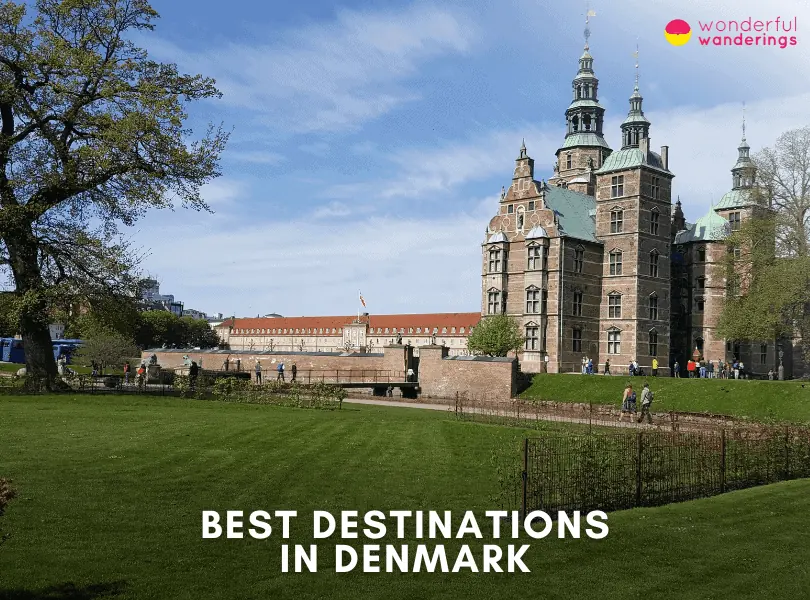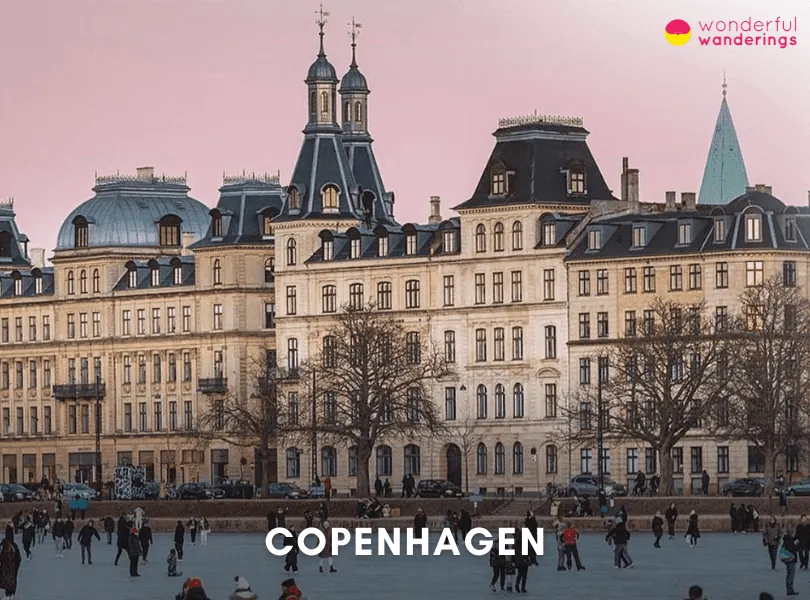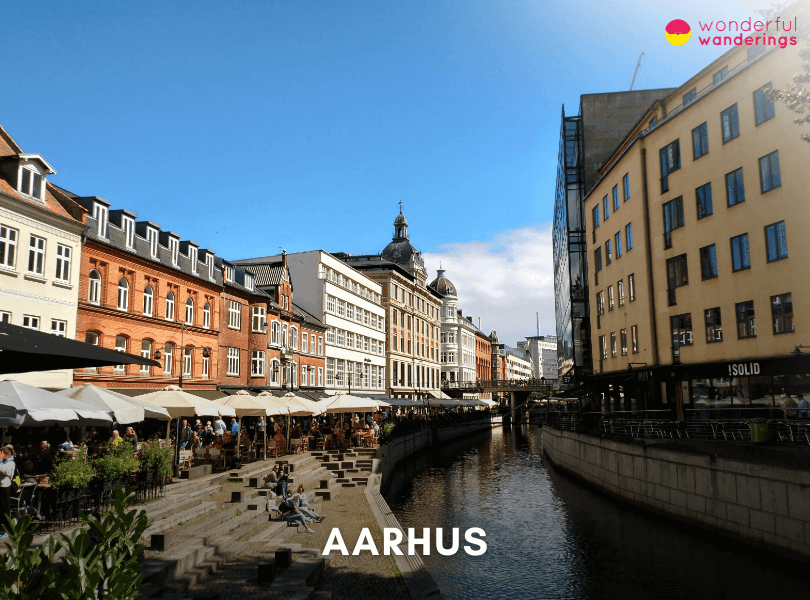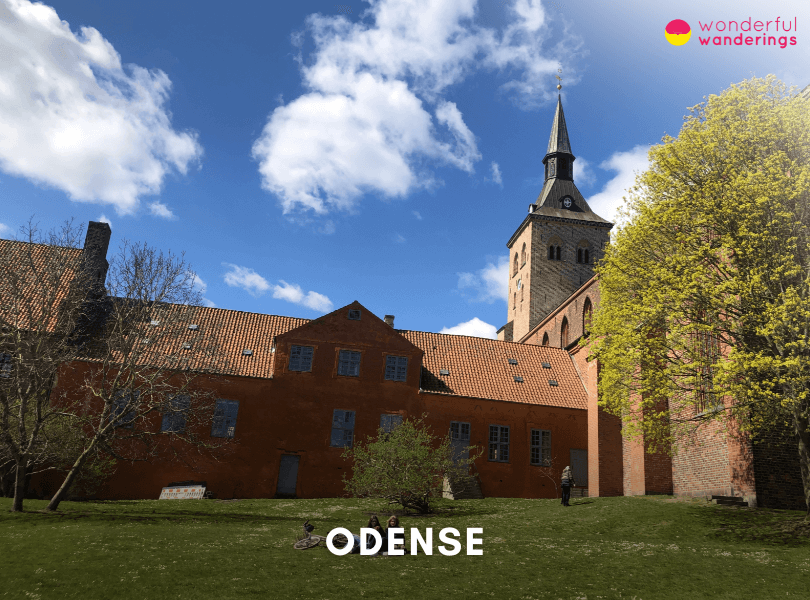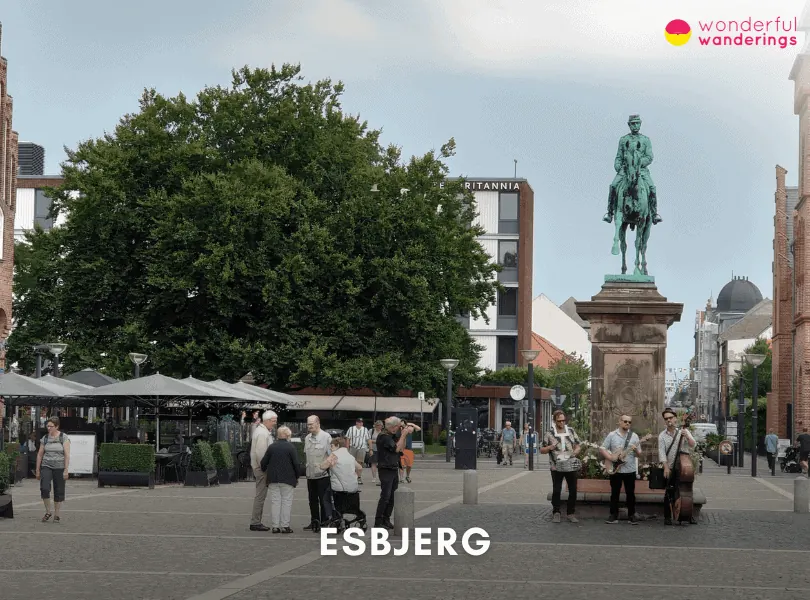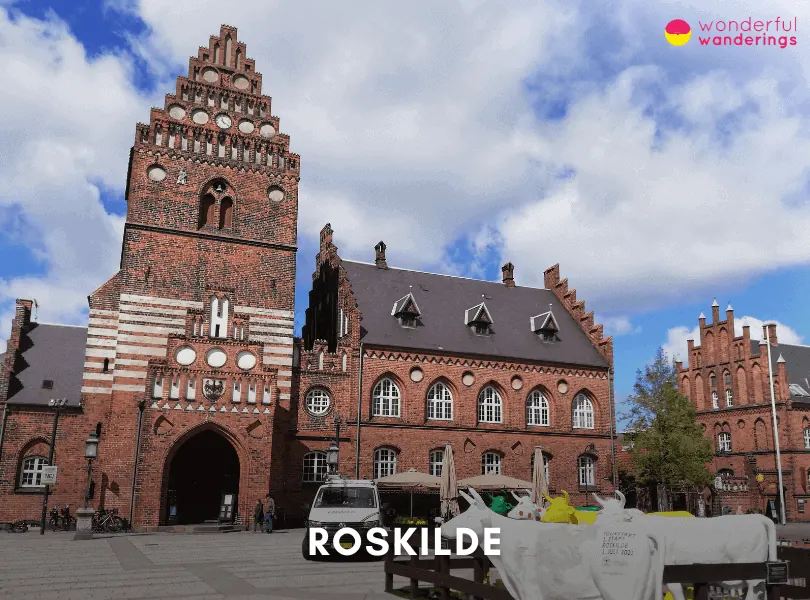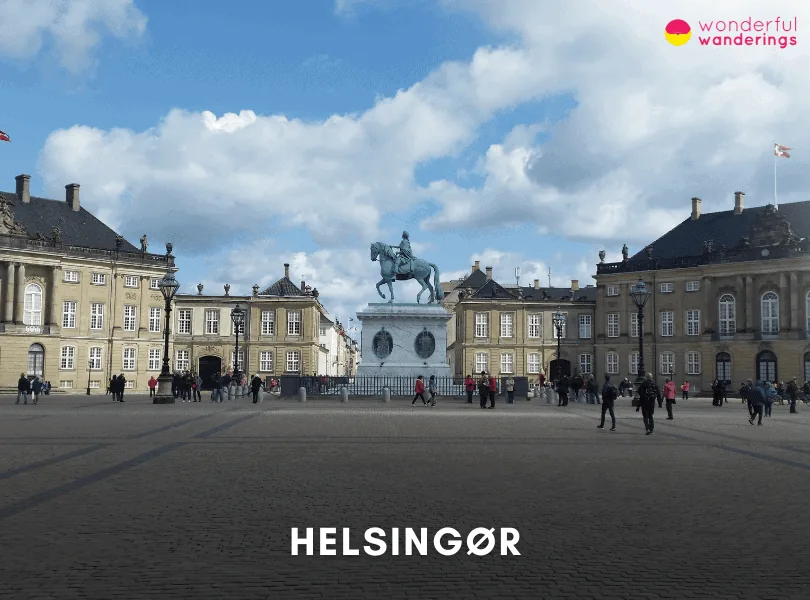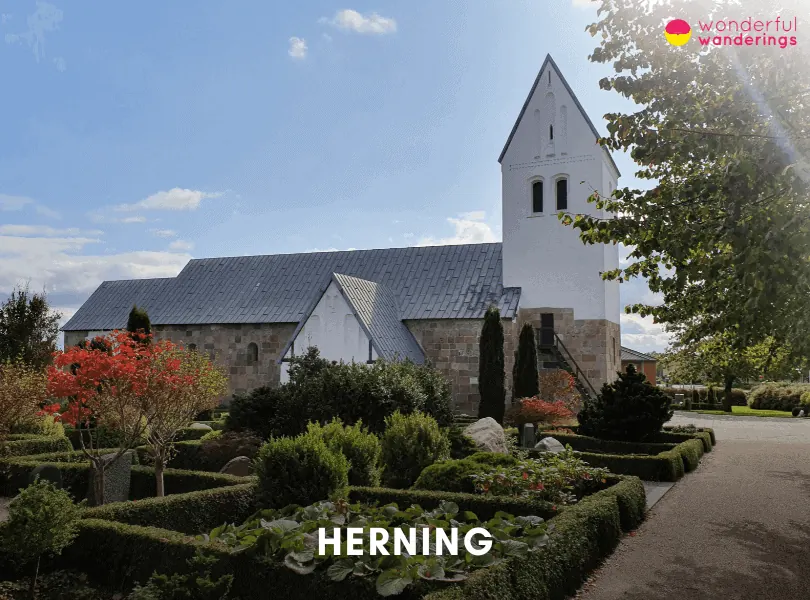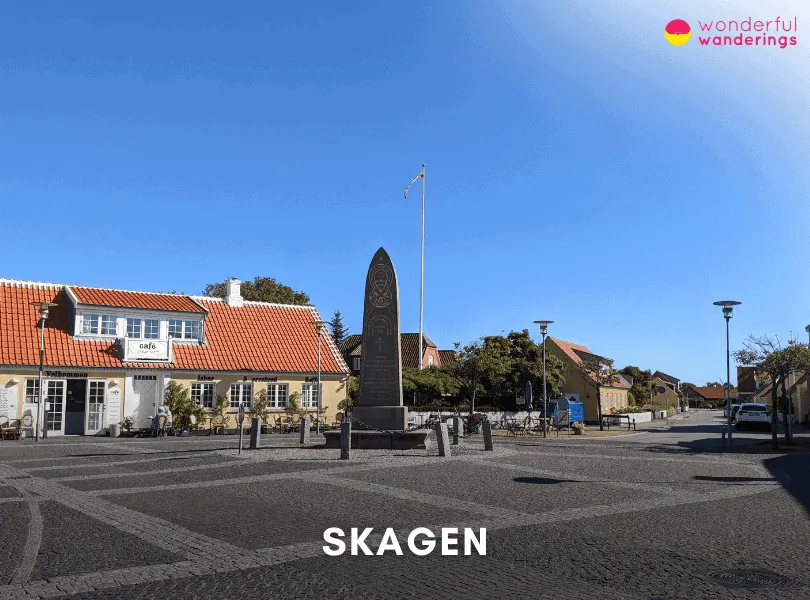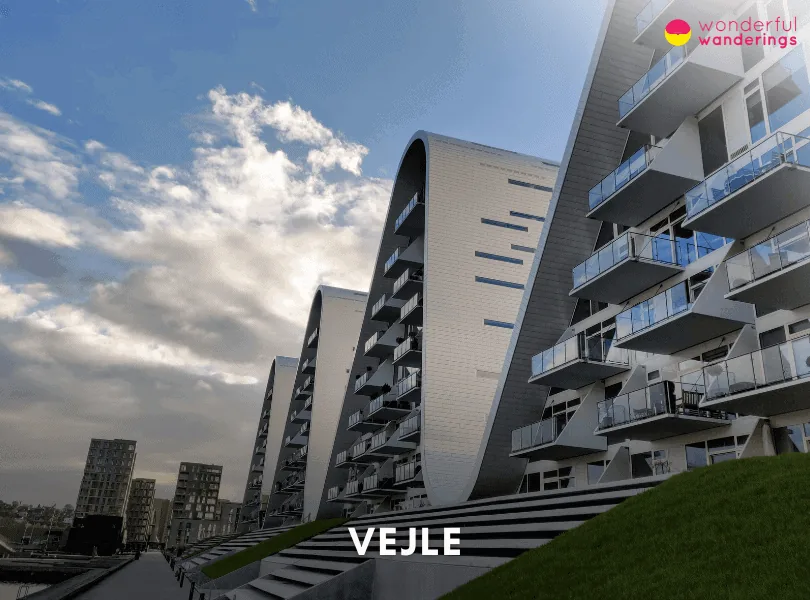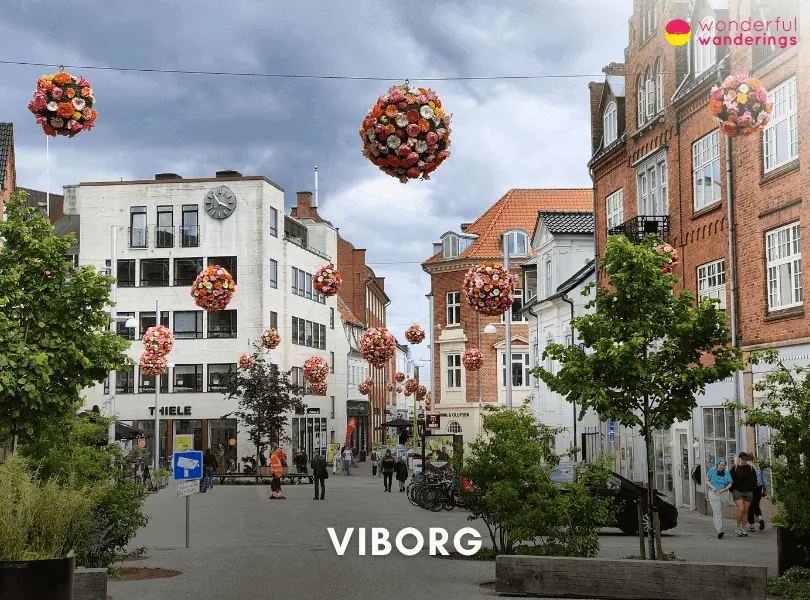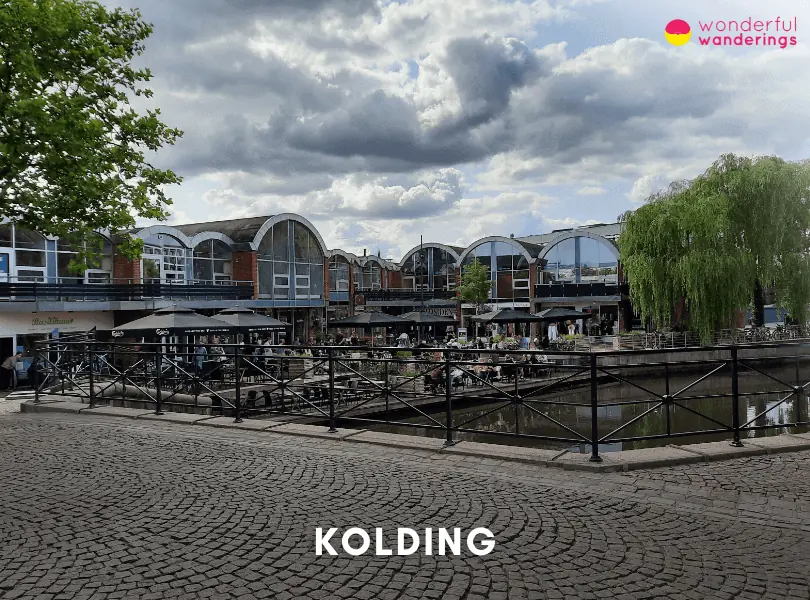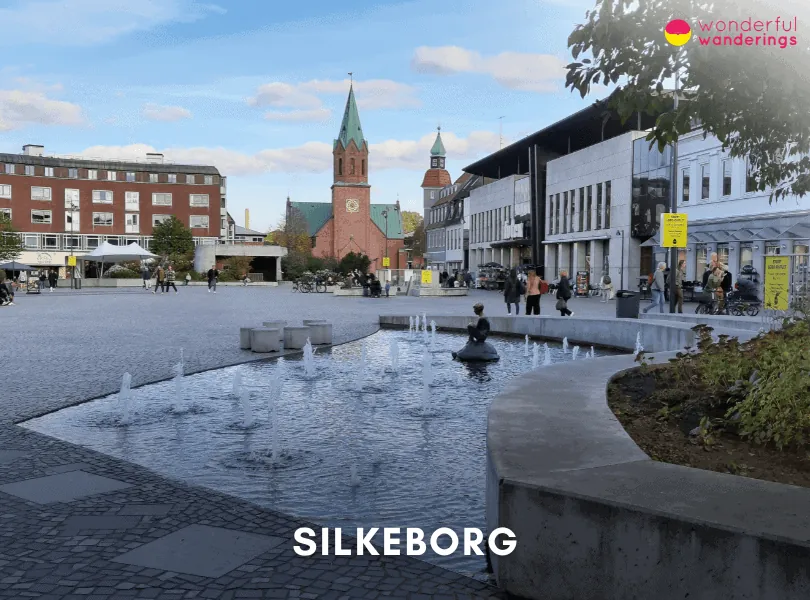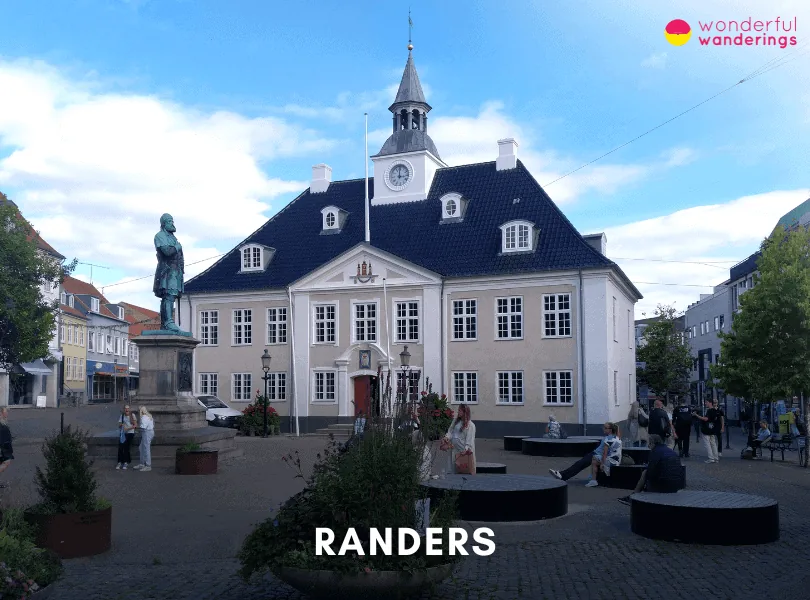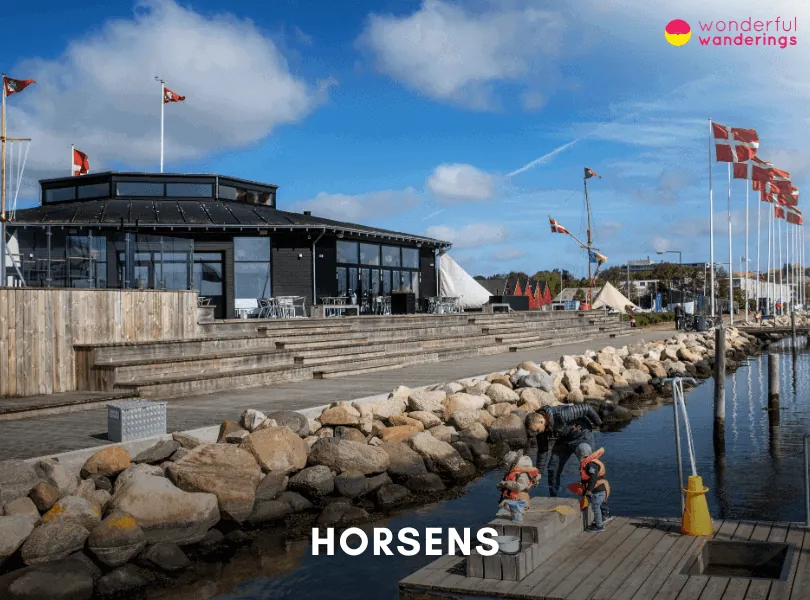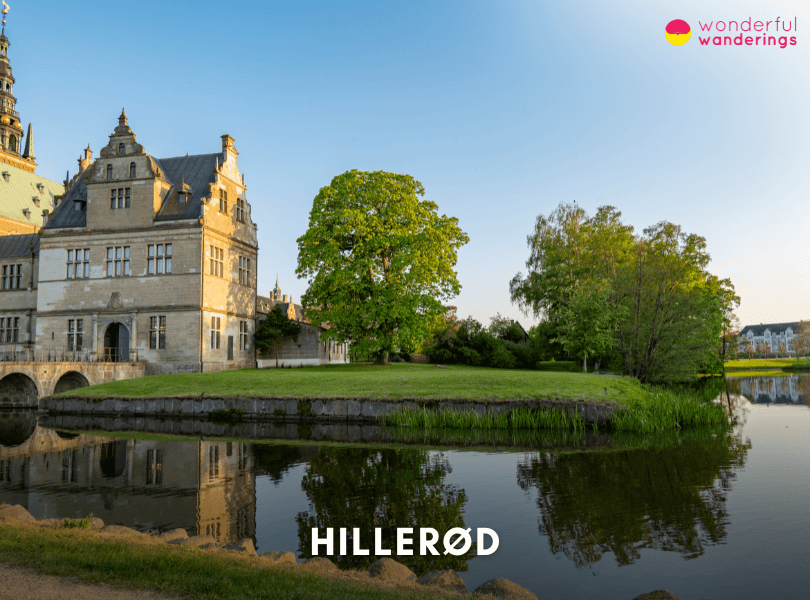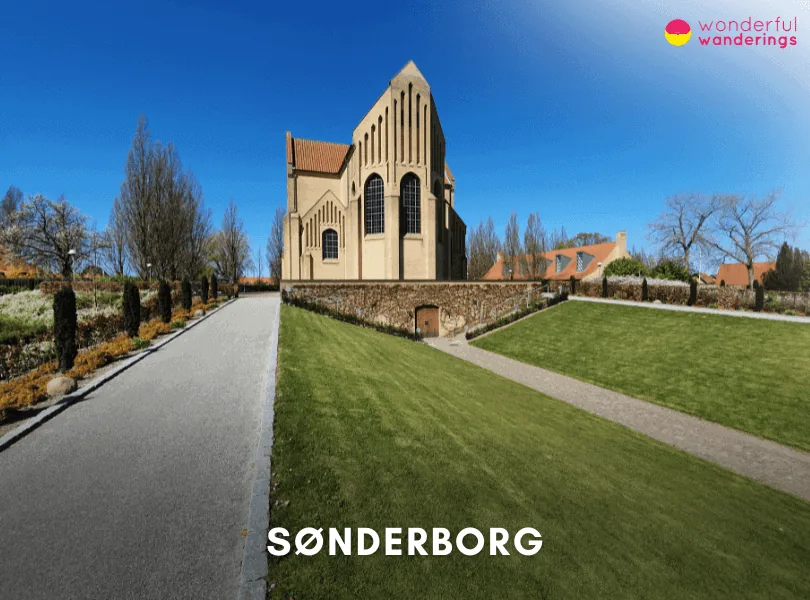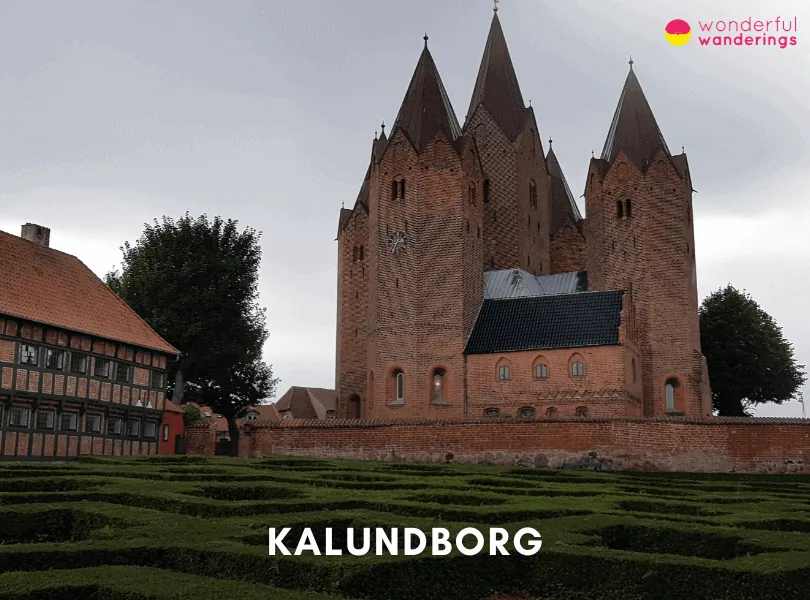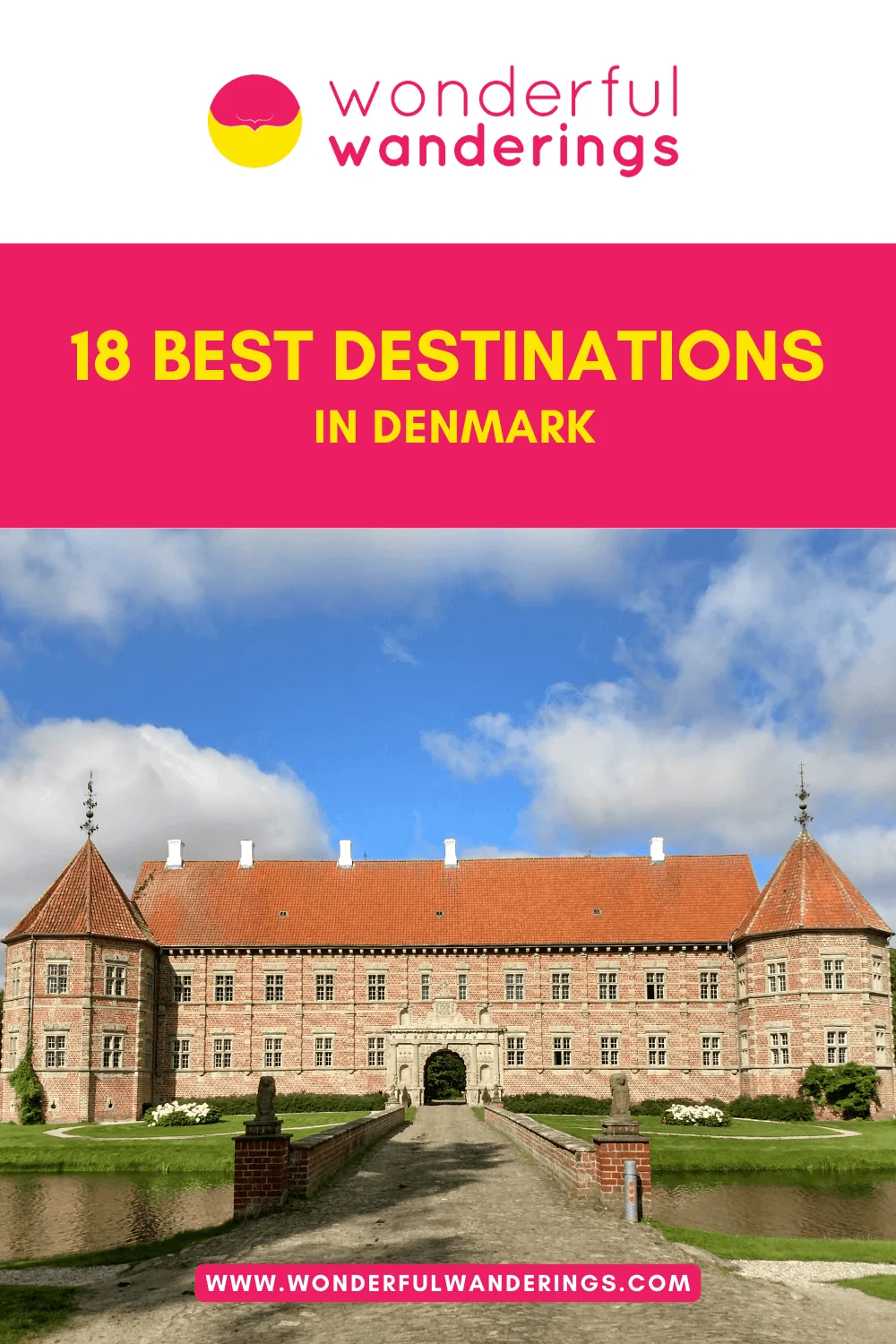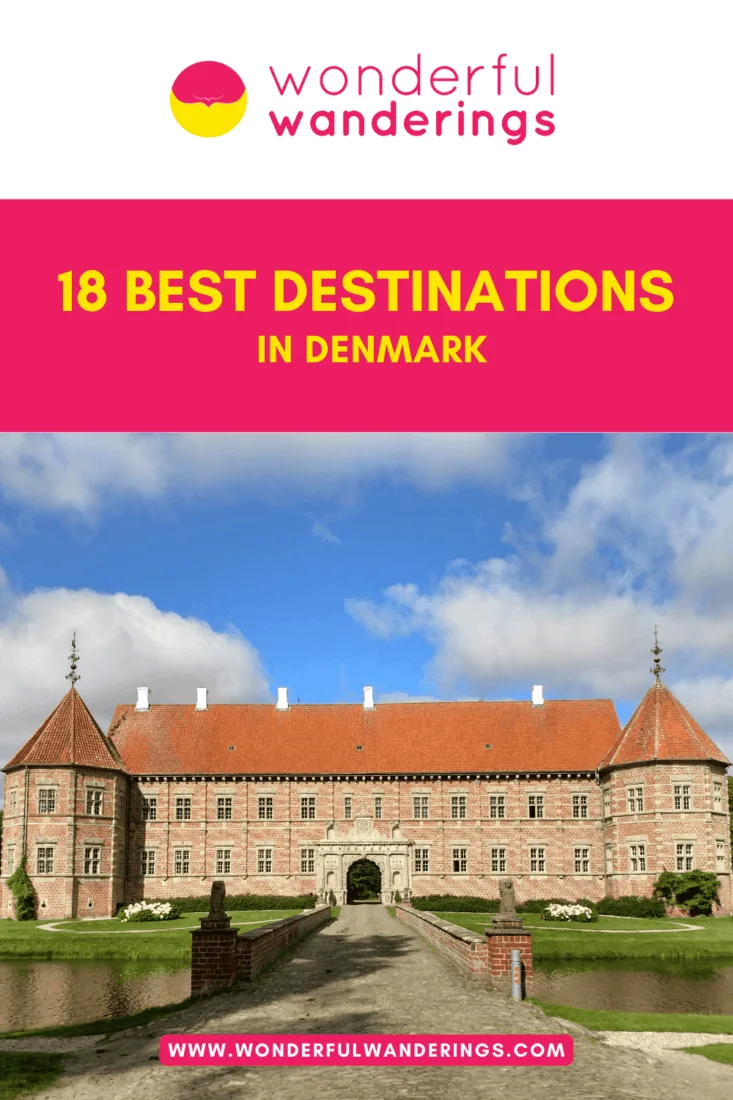Denmark is in Northern Europe and consists of the Jutland peninsula and over 400 islands, including the large islands of Zealand, Funen, Lolland, Falster and Bornholm. The landscape comprises rolling farmlands, forests, sandy coastlines with beaches, fjords and the Baltic Sea. The capital and largest city is Copenhagen, located on Zealand’s eastern coast overlooking the Øresund Strait. Other major cities include Aarhus, Odense, Aalborg and Esbjerg.
Copenhagen offers Tivoli Gardens, The Little Mermaid Statue, Nyhavn Canal, Amalienborg Palace, Rosenborg Castle and the SMK National Gallery. Copenhagen is home to the Louisiana Museum of Modern Art and Kronborg Castle, known as Elsinore in Shakespeare’s Hamlet. Aarhus features the ARoS art museum with Your Rainbow Panorama skywalk and Moesgaard Museum on Denmark’s prehistory. Odense has a museum dedicated to famous fairytale author Hans Christian Andersen. Denmark also has over 9,000-year-old Bøgebakken settlement and 7th-century Viking ship graves. Formal gardens grace Kronborg Castle and Liselund Mansion on the Baltic island of Møn. Denmark offers villages, coastal trails and peaceful nature. Top islands are Bornholm, Zealand, Funen, Lolland and Ærø. Notable beaches include Klampenborg’s Bellevue Beach and the long Amager Strand in Copenhagen. Visitors can experience everything from thousand-year-old Viking artifacts and sites to Denmark’s emergence as a global design, architecture and New Nordic cuisine leader.
Denmark offers year-round sightseeing opportunities. Summer months welcome warm weather best for city exploring, cultural festivals, amusement parks and beaches along Denmark’s extensive coastline with the Northern European Sea’s twist. Denmark’s winter offers an atmospheric wonderland for Christmas markets, ice skating, skiing and the signature Danish concept of “hygge”, enjoying simple comforts like fires, blankets and home-cooked meals. The best time to visit Denmark is in the summer. The weather is warm and sunny, with average highs around 70°F, making it perfect for exploring the country by bike or on foot.
1. Copenhagen
Copenhagen is on the eastern coast of the Danish island of Zealand, overlooking the Øresund Strait across from Sweden. Copenhagen is 1 kilometer (0.6 miles) from the center of the Capital Region of Denmark. Copenhagen’s history dates back to the 11th century when a small fishing village existed on the site of the present-day city. The village grew in importance after coming under the ownership of Bishop Absalon of Roskilde, who built a castle and fortified the town with ramparts and a moat in 1167. Copenhagen became an important trading hub and center of power, repeatedly attacked by the Hanseatic League. Copenhagen received an official town charter under Bishop Jakob Erlandsen.
Copenhagen offers cultural attractions spanning royal palaces, world-class museums, alternative neighborhoods, amusement parks, castles, beaches and more. The must-see highlights include the colorful waterfront district of Nyhavn, Tivoli Gardens, Amalienborg Palace, the Little Mermaid statue and SMK National Gallery housing Danish masterpieces. Visitors can explore Copenhagen’s history at sites like Kronborg Castle, where Shakespeare set Hamlet or stroll Strøget pedestrian street blending old and new. Copenhagen has captured world attention for its dining scene, landing multiple Michelin stars yearly. Danish cuisine mixes global influences with local ingredients. Smørrebrød open-faced sandwiches remain an enduring tradition now served in creative renditions. The New Nordic cuisine movement also sparked renewed pride in native fare like seafood.
Copenhagen has a total population of 1,169,408 people as of 2023. The geographic coordinates of Copenhagen are 55.6761° N and 2.5683° E. It sits 105 kilometers (65 miles) east of Aarhus, Denmark’s second-largest city. Copenhagen is located in eastern Denmark on the island of Zealand. Copenhagen is well-connected to the rest of the country by train, bus, car and plane. The nearest and most convenient major airport is Copenhagen Airport, 6.9 kilometers (8.8 miles) from central Copenhagen.
The best time to visit Copenhagen is spring, specifically April and May. The weather is milder and more pleasant than the winter months, with average highs around 11-16°C (52-61°F). The summer crowds and high prices have not yet arrived. There are also popular spring events and festivals happening during this shoulder season. Copenhagen can be spent at least three days. It allows enough time to explore neighborhoods like the Nyhavn canal area, visit iconic attractions like Tivoli Gardens amusement park and the Little Mermaid statue, see important landmarks such as Amalienborg Palace and Rosenborg Castle, stroll along Strøget shopping street, take a day trip to Kronborg Castle where Shakespeare’s Hamlet. Three days also gives time to venture north of Copenhagen to the Louisiana Museum of Modern Art and experience the Danish countryside and coastline.
2. Aarhus
Aarhus is located on the east coast of the Jutland peninsula in central Denmark. It sits along the Aarhus Bay, facing the Kattegat Sea, 187 kilometers (116 miles) northwest of Copenhagen.
Aarhus has an ancient history dating back to the Vikings in the 8th century. Its name comes from the words “Aar”, meaning river and “os”, meaning mouth, referring to the city’s origins as a settlement at the mouth of the Aarhus River. It was an important trading center and port during the Viking Age due to its location at the intersection of sea routes. Aarhus continued to grow into a prosperous medieval market town and became an important religious center in the 10th century as the seat of a bishopric. The city underwent major expansion and industrialization in the 1800s with the advent of the railway connecting it to other cities. Aarhus has evolved to become one of the largest ports in Denmark and a center for education, technology and trade.
Aarhus’s top tourist attractions include the Tivoli Friheden, which offers a blend of amusement parks. Aarhus Cathedral stands as the largest church in Denmark, reflecting the city’s medieval past with its Gothic architecture and frescoes. The Concert Hall Aarhus is the largest concert venue in Scandinavia, hosting various events and performances. ARoS Aarhus Art Museum is a must-visit for visitors interested in arts, with its Danish works and international contemporary art. Moesgaard Museum and The Old Town Museum offer historical insights, while Kvindemuseet focuses on women’s cultural history. Families visiting Aarhus can enjoy various activities at places like the ARoS Aarhus Art Museum, Tivoli Friheden Amusement Park and Moesgaard Museum.
Copenhagen has a total population of 240,802 as of 2023. The city center is at the mouth of the Aarhus River, which runs through the valley and empties into the bay. Aarhus is the seat of Aarhus Municipality and the second largest city in Denmark after Copenhagen. Its geographic coordinates are 56.1629° N and 10.2039° E. The nearest major airport to Aarhus is Copenhagen Airport, 187 kilometers (116 miles) away and 147 kilometers (91 miles) from the capital city. The best and most convenient way from Århus to Copenhagen Airport is to fly, which takes 2 hours and 17 minutes.
The best time to visit Aarhus is in the summer, specifically June through August. The weather is pleasantly warm, with average highs around 17-21°C (63-70°F) and minimal rainfall, with an average of 16-19 rain-free days per month. Summer also brings long daylight hours for exploring the city’s sights and participating in cultural events and festivals. The days needed to see Aarhus are 2 to 3 days. Aarhus is compact and the main attractions can be seen on a weekend getaway. Visitors can focus their time on top sights like the rainbow skywalk at ARoS Art Museum. An optional third day allows further exploration of the Moesgaard Museum, beaches and historic areas outside the city. Aarhus’ manageable size can experience the essence of the city and its culture in just a couple of days without feeling rushed.
3. Odense
Odense is on the Danish island of Funen in central Denmark. It is situated in the northeastern part of the island, around 30 km (19 miles) from the coast of the Great Belt strait, separating Funen from the more oversized Zealand island. Funen lies between the peninsula of Jutland to the west and Zealand to the east. Odense is centrally positioned on the Danish rail network with direct connections to Copenhagen and other major cities. The name Odense is derived from Odins Vi, meaning “Odin’s Sanctuary”, as the area was a worship center for the Norse god Odin. King Canute IV was killed in Odense and later canonized, making the city an important pilgrimage site during the Middle Ages. Odense grew into a prosperous medieval market town and was chartered in 1335. The city is most famous as the birthplace of author Hans Christian Andersen in 1805.
Odense features Denmark’s first saint, the martyred King Canute IV, whose shrine remains in St Canute’s Cathedral. The cathedral is one of the oldest and most impressive churches in Denmark. Odense has an extensive network of bike paths throughout the city and the surrounding countryside. Locals embrace cycling as an everyday mode of transportation. The city has over 300 bike paths, unique bike bridges and tunnels. Odense’s biking culture reflects the national passion for cycling in Denmark. The Hans Christian Andersen Museum in Odense delves into the author’s imaginative world. The Brandts Museum of Art & Visual Culture showcases a remarkable array of Danish and international art, making it a haven for art lovers. The city caters to its young visitors with attractions like the Odense River Safari, a scenic boat tour and The Funen Village, offering an interactive historical experience. The Odense Zoo is a hit among kids for its up-close animal encounters and the Odense Puppet Theater provides captivating performances for the little ones.
Odense has a total population of 147,929 as of 2023. It is Denmark’s third largest city by population, after Copenhagen and Aarhus. The geographic coordinates are 55.4038° N and 10.4024° E. It is located centrally in Funen, Odense and is connected to vital Danish cities by significant transport routes. The nearest major airport is Copenhagen Airport, 105 kilometers (65 miles) east of Odense and 167 kilometers (104 miles) from Copenhagen city center. The fastest and most convenient way to travel between the two cities is by train. Regular direct train services cover the distance in 1 hour and 9 minutes and trains frequently run throughout the day.
The best time to visit Odense is in the summer, specifically June through August. The weather is pleasantly warm, with average highs around 15-21°C (59-70°F) and moderate rainfall, with around 7-9 rainy days per month. The summer also offers long daylight hours to explore Odense’s cultural sights, partake in events and festivals and enjoy the outdoors. The days needed to see Odense are 2 to 3 days. In one day, visitors can visit the key highlights, including Hans Christian Andersen’s childhood home, the H.C. Andersen Museum and House, the Brandts Arts Center, Odense Cathedral, Møntergården historic houses and the shopping streets. Two days allow time to see more museums like the Hans Christian Andersen Fairytale House, take a riverboat tour or visit the zoo. Three days would provide a more relaxed visit to soak up the atmosphere, see more neighborhoods and visit nearby attractions like Egeskov Castle.
4. Aalborg
Aalborg is a port city in northwestern Denmark, at the narrowest point of the Limfjord Sound. Aalborg has long served as an important harbor and industrial center. The area around Aalborg has been settled since around 700 AD due to its strategic location on the Limfjord. In the Middle Ages, Aalborg grew wealthy as a trading center and member of the Hanseatic League. The city later prospered as a major industrial port, exporting spirits, cement and agricultural products by the late 19th century. Aalborg is transitioning into a knowledge and green energy economy, anchored by the university and holding ambitions to increase high-tech exports.
Aalborg offers a lively cultural scene. The major attraction is the annual Aalborg Carnival, the biggest event in Scandinavia, held at the end of May. The city also holds several history and art museums, including the Lindholm Høje Viking Museum and the Kunsten Museum of Modern Art, designed by Finnish great Alvar Aalto. Other top sites range from the 16th century Aalborghus Castle, the historic Jens Bangs Stenhus merchant house, to the striking 1933 Utzon Center for Architecture and Design. Visitors may prefer exploring the cobbled streets of the old town center, the harborfront promenade or green spaces like the Kildeparken.
Aalborg has a population of 123,922 as of 2023 within its area of 50 square kilometers (19 square miles). Aalborg’s geographic coordinates are 57°2′N 9°55′E. Copenhagen Airport and Aalborg Airport are 239 kilometers (148 miles) and 363 kilometers (225 miles) from the capital city, respectively. The best way is to take a flight. The best way to travel between the airports is likely to take a short 46-minute flight.
The best time to visit Aalborg is during late spring and summer, from May to August when average highs reach a pleasant 20°C. Many cafés open outdoor seating along the Østerå River, while the long days allow time to explore outlying areas like Rold Forest. With three full days in the city, visitors can devote one each to top museums, the old town and the harbor district. Visitors cannot miss stopping for an afternoon coffee on Jomfru Ane Gade, dubbed Aalborg’s liveliest people-watching promenade or sampling local aquavit spirits. Visitors may join the many university students hitting the bars and clubs to experience Aalborg’s famous nightlife.
5. Esbjerg
Esbjerg is on Denmark’s southwest Jutland west coast. The city is an important shipping and ferry hub connecting England and Norway. It developed rapidly in the late 19th century due to the area’s thriving fishing industry. The area was first mentioned in the 13th century but remained sparsely populated until the late 1860s. The rapid establishment of Esbjerg itself began in 1868 when the Danish government decided to build a new port city here, then known as a health wasteland. Its strategic harbor location between the North and Baltic Sea led to large export industries like fish processing and shipping. Esbjerg continues to grow as an important cargo and ferry terminal linking Denmark to the UK and Scandinavia.
Esberg features an array of popular sites, including the Esbjerg Art Museum, with its impressive collection of modern Nordic art and the Man Meets the Sea Museum, which chronicles the city’s maritime history. The city also hosts family-friendly attractions like the Esbjerg Performing Arts Centre, the publicly displayed Old Town open-air museum and the large Esbjerg Strand beach park. Hiking trails along the coast and day trips to Ribe and Legoland within driving distance add to the area’s draw of tourists.
Esbjerg has a population of 72,168 as of 2023. The city center lies about 5 meters above sea level with an elevation reaching 25 meters in the suburbs. Esbjerg is at latitude 55°29′N and longitude 8°26′E along the southwestern edge of Jutland. The distance from Esbjerg to Copenhagen Airport is 307 kilometers (190 miles) and to central Copenhagen, it is 262 kilometers (162 miles). The best way to get through the cities is through domestic budget airlines that offer flights between Copenhagen and Esbjerg Airport in an hour.
The summer months from June to August are ideal for visiting Esbjerg. Average temperatures reach around 17°C, perfect for enjoying the spacious Blue Flag beach and waterfront activities. From May to September, the ferries also run frequently to Fanø Island. Annual events like the Four Days Walk marching festival also occur in summer. Visitors can explore the top attractions of Esberg within two days, such as the maritime and art museums, wander the historic downtown area and relax at the harbor or beaches. Nearby day trips extend options to the Wadden Sea island of Fanø, the old town of Ribe or the Legoland theme park. Highlights include sampling fresh seafood, checking out the music scene and wandering the scenic coastal paths.
6. Roskilde
Roskilde is a historic city on the Danish island of Zealand, west of Copenhagen. It was the capital of Denmark until 1443 and remains an important cultural and religious center. Roskilde was an important trading center and seat of royalty in the Viking Age, serving as the capital of Denmark from 1020 to 1443. Many Danish kings and queens have been buried in Roskilde Cathedral. The city has an especially rich religious history as the seat of the Bishop of Roskilde since about 1060. Roskilde lost prominence after the capital moved to Copenhagen but remains the center of culture and learning.
The imposing Roskilde Cathedral, begun in 1170, is a UNESCO World Heritage Site in Roskilde. The Gothic cathedral houses royal crypts with 39 Danish kings’ and queens’ tombs. The Viking Ship Museum on the fjord features five excavated 11th-century Viking ships, exhibitions and hands-on activities. Roskilde also hosts the Roskilde Festival, one of Europe’s largest music festivals, attracting over 130,000 attendees. An interactive RAGNAROCK museum focused on pop, rock and youth culture opened in 2016. Other attractions include the former royal residence near the cathedral, now an art museum with contemporary art exhibitions.
Roskilde has a total population of 90,446 as of 2023. Roskilde is in the Region Zealand administrative division in eastern Denmark on the island of Zealand. The city has a longitude and latitude coordinates of 55°39′N 12°06′E. It sits on the Roskilde Fjord, 30 kilometers (18 miles) west of Copenhagen city center and airport. The best way to travel to both cities is by Frequent train service from Copenhagen’s main station, which takes 20-25 minutes.
The best time to visit Roskilde is in the summer, specifically June through August. The weather is pleasantly warm during this period, with average high temperatures around 15-22°C (59-72°F) and moderate rainfall, with an average of 5-10 rainy days per month. These months have mild weather and long daylight hours to enjoy the outdoor attractions. Most visitors see Roskilde as a day trip from Copenhagen. Visitors need at least 2-3 days to experience Roskilde. Visitors can see the cathedral and Viking Ship Museum and explore Roskilde’s quaint old town center along Skomagergade with restaurants and cafés. Visitors can also wander through the Boserup Forest, take a boat trip to the Jars sculpture on the fjord and see more museums like the rock music museum RAGNAROCK.
7. Helsingør
Helsingør is on the northeastern coast of Zealand, Denmark’s largest island, north of Copenhagen. Helsingør has a long history dating back to the 1420s, founded by the Danish king Eric of Pomerania. He established the Sound Dues, which required all foreign ships passing through the Øresund to pay a toll, bringing considerable wealth and status to Helsingør. This led to the expansion of Kronborg Castle, the most significant landmark in Helsingør today. William Shakespeare chose Kronborg as the setting for his famous play Hamlet, adding to the castle’s fame.
Helsingør is home to the immense Renaissance Kronborg Castle, a UNESCO site on the coastline with a museum, casemates and summer performances of Hamlet. The city’s cultural hub is the Kulturværftet Cultural Center in a converted shipyard, housing the Danish Maritime Museum and Helsingør City Museum, hosting events and concerts. Helsingør Cathedral originated as a 13th-century monastery church with beautiful architecture, royal tombs and centuries of history. The old town city center has cobblestone streets, half-timbered houses, shops, cafés and restaurants with classic Danish characters.
Helsingør has a total population of 62,212 as of 2023. Helsingør sits at the narrowest point of the Øresund, the strait between Denmark and Sweden. The GPS coordinates of central Helsingør are 56°02′N 12°37′E. Helsingør is 35 minutes by car from Copenhagen Airport, 45 kilometers (28 miles). It is a 45-minute drive from Copenhagen city center, which is 50 kilometers (31 miles). The best way to reach Helsingør is by train. There are trains at least every 20 minutes from Copenhagen Central Station that take 45 minutes.
The best time to visit Helsingør is in the summer, specifically June through August. The weather is pleasantly warm, with average highs around 18-21°C (64-70°F) and minimal rainfall, with around 5-9 rainy days per month. The summer also offers long daylight hours to explore Helsingør’s sights like Kronborg Castle, partake in cultural events and enjoy the outdoors. Spending two full days in Helsingør is recommended, which allows enough time to fully explore its museums, castle, old town, ferry trip to Sweden and more. Visitors can do day trips to Kronborg Castle, the Kulturværftet cultural center, Helsingør Cathedral, wander the city center and take a ferry to Helsingborg. Key sites include the dramatic Kronborg Castle, the Danish Maritime Museum and the historic narrow streets of central Helsingør.
8. Herning
Herning is a town in the central part of Jutland, the peninsula that makes up mainland Denmark. It is in the Central Denmark Region and is the main town and administrative seat of Herning Municipality. Herning was established in the early 1790s, during the heath reclamation period, as a commercial center providing goods and services to local farmers. It later became an important center for the textile industry, once its principal economic activity. Today, Herning has a more diversified industrial base, including many small furniture and textile businesses.
The city is also home to unique buildings designed by acclaimed Danish architect Jørn Utzon and the monumental sculpture Elia by Ingvar Cronhammar. Visitors can tour the historic Herningsholm Estate and the beautiful grounds of Classensborg Estate. The Herning Museum offers exhibits on the history of the city and textile production. Sports enthusiasts can catch a hockey match featuring the local team Herning Blue Fox or a football game with FC Midtjylland at the MCH Arena stadium. Cycling is huge in Herning, which hosts the Tour of Denmark professional bike race annually. The small city center has ample shopping, dining and nightlife opportunities.
Herning has a total population of 51,193 as of 2023. The city sits at an elevation of 58 meters (190 feet) above sea level. Its geographic coordinates are 56°08′10′′N, 8°58′36′′E. Herning is located about 269 kilometers (167 miles) west of Copenhagen Airport and Copenhagen city center. The best way to reach Herning is by train. There are hourly train connections from Copenhagen that take 3.5 hours. By road, Herning lies at the intersection of three major highways and is a 3-hour drive from Copenhagen. Its location makes it easily accessible for a quick getaway or a longer stay to explore the sights.
The best time to visit Herning is in the summer months of June, July and August. The months with the warmest average temperatures are June, July and August, with average highs around 18-22°C (64-72°F). June through August have lower chances of rain and precipitation than other months, with 5-10 rainy days per month on average. The summer months offer long daylight hours to explore sights and partake in events and festivals. Plan to experience Herning and spend 2-3 days in the city to see the key attractions. Top sights include the HEART Herning Museum of Contemporary Art, with works by renowned Danish and international artists. The Carl-Henning Pedersen & Else Alfelts Museum showcases artworks by the famous married artist couple.
9. Skagen
Skagen is on the northern tip of Jutland, the mainland Denmark peninsula. It is part of Frederikshavn Municipality in the North Denmark Region. The town’s origins date back to the 12th century when it was just a small fishing village. Its strategic location near rich fishing grounds helped it become an important fishing port and maritime center over the centuries. Tourism started booming in the late 19th century after Skagen became popular with artists drawn to its scenic landscapes and fishing culture.
Top attractions in Skagen include Grenen, where two seas meet, with chances to see seals sunbathing on the sandbar. The Cape Skagen Grey Lighthouse offers panoramic views from Denmark’s northernmost point. Skagen Museum showcases an exquisite collection of paintings by 19th-century artists who flocked here. Østerby’s narrow alleys and Gammel Skagen’s fishing huts provide a glimpse into traditional local life. The diverse landscape around Skagen offers hiking trails, white sand beaches, sheltered harbors and more for visitors to explore. Visitors can also indulge in fresh seafood, boutique shopping, boating trips and Skagen’s lively nightlife scene.
Skagen has a total population of 9,882 as of 2023. It covers a mainland area of 354 km2 with an additional 93 km2 of water area. It is where the waters of Kattegat and Skagerrak meet. The city’s coordinates are 57°44′N and 10°35′E. Skagen lies 506 kilometers (314 miles) north of Copenhagen Airport and Copenhagen city center. The best and fastest way to reach Skagen from Copenhagen is taking a flight to Aalborg Airport, followed by an hour’s drive or bus transfer to Skagen.
The summer months, from June to August, are the most popular time to visit Skagen. The weather is pleasantly warm, with average highs around 15-20°C (59-68°F) and moderate rainfall, with an average of 5-10 rainy days per month. The annual Skagen Festival, celebrating art & culture, is held in July. To fully experience Skagen, visitors must plan a 2-3 night stay. Visitors can wander Skagen’s old town, visit the Skagens Art Museum, have a seafood lunch by the harbor, walk out to the sand spit tip at Grenen, where two seas meet and see seals and the striking white lighthouse. Explore the historic fishing hamlet, Gammel Skagen, see fishermen and wooden boats, visit the poet’s grave, browse galleries and shops in the afternoon, take long sunset strolls on wide sandy beaches south of town and have gourmet dinner to end the trip.
10. Vejle
Vejle is along the Vejle Fjord in eastern Jutland, Denmark. Vejle is 105 kilometers (65 miles) west of Copenhagen and is known for its historic charm, architecture and location. The history of Vejle dates back to the late 12th century when it was originally a fishing village. Vejle was an important trading center and market town in the Middle Ages, eventually receiving its town privileges in 1327. Fishing and trade along the fjord were vital to Vejle’s economy. In the 19th century, the town transitioned towards more industrial production by establishing several factories and workshops.
Some of Vejle’s top attractions that draw tourists include the Vejle Fjord and harbor area, the historic Old Town with its cobblestone streets and half-timbered houses, the Town Museum exhibiting the history of Vejle and outdoor recreation areas like the Lerbæk Woods nature site. Popular annual cultural events include the Vejle Flower Festival, showcasing horticultural displays and the Vejle Viking Market, bringing history to life. The main areas of Vejle include the pedestrianized town center surrounded by shops and restaurants, the green spaces and marina along the fjord and the suburban neighborhoods spread out around the outskirts. The iconic Town Hall building from the late 19th century houses the administrative offices and faces the Town Square, while the twin church spires of the impressive Gothic-style St. Nicolai Church from the late 1400s dominate the skyline.
Vejle has a total population of 57,086 as of 2023. Vejleis is at geographic coordinates 55°43′N 9°33′E. Vejle is located 175 kilometers (109 miles) west of Copenhagen Airport and Copenhagen city center. An efficient option to reach Vejle is flying to Billund Airport from Copenhagen Airport, a 45-minute flight. Visitors can also consider taking a train from Copenhagen Central Station to Vejle Station, which takes 2 hours and 15 minutes.
The best time to visit Vejle is during the summer months of June through August. The weather is mild, with average high temperatures around 70-79°F; when daylight hours are long, the weather is mild and many town events are scheduled. Two to three days provide enough time to explore Vejle’s main attractions. Top things to do include wandering the Old Town streets while admiring the architecture, taking a boat tour of Vejle Fjord, learning about the town’s history at the museum, shopping and dining downtown, renting a bicycle and traversing the countryside trails and simply relaxing in the parks and green spaces sprinkled throughout the town. Vejle also offers plenty of options for outdoor recreation like swimming, fishing, hiking and picnics for visitors looking to embrace nature and the natural beauty of Denmark.
11. Viborg
Viborg is a city in central Denmark, in the Central Denmark Region. It is the capital of Viborg Municipality, the second-largest municipality in Denmark, covering 3.3% of the country’s total land area. Viborg is known for its rich history, dating back to the late 8th century and its strategic importance in political and religious matters during the Viking Age. The city’s name combines two Old Norse words, “vi”, meaning a holy place and “borg”, meaning a fort, reflecting its historical significance.
Viborg is famous for its historic Viborg Cathedral, known for its paintings by Danish painter J.L. Lund, depicting Bible stories. The construction of the cathedral started in 1130 and took about 50 years. The building has burned to the ground and has been rebuilt several times. Only the crypt of the original cathedral is still preserved. The cathedral was and is the locus of the cult of Saint Kjeld, who was dean of the cathedral chapter and had a great shrine there in the Middle Ages. Next to the cathedral is the Viborg Museum, founded in 1937. Before the Reformation, Viborg was the home of five monasteries, about 12 parish churches, several chapels and a cathedral. The Black Friars’ church dates from the 13th century. Today, only the cathedral and a few remains of the Franciscan and the Dominican monasteries are left.
Viborg has had a reputation as one of Denmark’s leading cities for handball. It started with Viborg HK, a popular sport in Denmark when the women’s handball team became one of the best five clubs in Europe.
Viborg has a total population of 42,234 as of 2023. Vejle is located at geographic coordinates 55°43′N 9°33′E. Viborg is 260 kilometers (162 miles) west of Copenhagen Airport and 250 kilometers (155 miles) west of Copenhagen city center. The best way to get to Viborg is by train, as the city is served by Viborg Station, located on the railway between Copenhagen and Aarhus, offering direct services to both cities. Viborg is also accessible by road and has an airport for international travel.
The best time to visit Viborg is during the summer months of June to August, when the weather is mild and there are plenty of outdoor activities and cultural events to enjoy. The average temperature is 20-25°C (68-77°F), making it ideal for outdoor activities. A two-day visit to Viborg allows visitors to explore the city’s historic sites, attend sports events and enjoy local cuisine at various restaurants and cafes. Top attractions in Viborg include the historic Viborg Cathedral, the Viborg Museum and the annual Haervejsmarchen international two-day walking festival, which regularly attracts 8,000 participants, including many from outside Denmark.
12. Kolding
Kolding is a port city in southeastern Denmark at the head of Kolding Fjord, an inlet of the Little Belt strait. It sits in the Region of Southern Denmark and is the seat of Kolding Municipality. Kolding has a long history dating back to at least the 10th century AD. It grew up around Koldinghus Castle, a royal castle built in 1268 to defend Denmark’s southern border. Kolding was one of the country’s most important castles and royal residences. Several key events occurred at or near Kolding, like battles against Sweden in the 17th century and against German forces in 1849. The castle burned down in 1808 but was partially restored and now operates as a museum.
The main attraction in Kolding is the Koldinghus Castle complex, which contains the castle itself, a chapel, ceremonial halls and gardens. The castle tower offers panoramic views over the city and fjord. Meanwhile, the Koldinghus Museum focuses on Danish art and design. Another top site is the 13th-century Church of Saint Nicholas, Denmark’s oldest functioning church. The Trapholt Art Museum features modern Danish art and has an extensive chair collection. The 14-hectare Geografisk has a botanical garden that displays over 2,000 species of trees and plants. Kolding offers good shopping and an array of restaurants and cafés in its pedestrianized town center. The city is also home to the Design School Kolding and the University of Southern Denmark’s Kolding campus.
Kolding has a total population of 62,338 as of 2023. The geographical coordinates of Kolding are 55°28′N 9°28′E. It is 245 kilometers (152 miles) west of Copenhagen and Copenhagen Airport. The best way to get to Kolding is by train, as Kolding railway station sits on the triangular railway line between Copenhagen, Aarhus and Fredericia, with direct trains to Copenhagen taking 2.5 hours. Kolding can also be reached from Copenhagen by car via the E20 motorway in 2 hours.
The best time to visit Kolding is late spring through early fall (May- September), which tends to have the mildest weather and most sunshine. Temperatures average around 60°F (15°C) during the day. Two days in Kolding would allow enough time to see the main attractions. Potential itineraries could include a walking tour of Kolding’s town center and historic Latin Quarter, visiting Koldinghus Castle, museum and grounds, Lunch at a cafe along the fjord and afternoon shopping and free time. The trip may include a morning visit to the Trapholt Museum, an afternoon trip to Geografisk Botanical Gardens and dinner at one of Kolding’s pizzerias.
13. Silkeborg
Silkeborg is in central Jutland, Denmark, between Aarhus and Viborg. It sits on the Gudena River and is surrounded by one of Denmark’s largest forest areas and a network of lakes, collectively known as the Silkeborg Lakes. This natural setting with ample opportunities for outdoor recreation has earned Silkeborg the nickname “Denmark’s Outdoor Capital”.
Silkeborg has a history dating back to the 15th century when a castle, monastery and farm were established in the area. A trading center soon emerged and by 1900, Silkeborg gained official town privileges. Silkeborg prospered as a popular tourist destination with abundant nature, outdoor recreation and cultural attractions. Major sites include the Museum Jorn, showcasing works by Danish painter Asger Jorn; the lakeside Silkeborg Museum with its displays of ancient bog mummies; Aqua freshwater center with animals and aquariums; Himmelbjerget, one of Denmark’s highest points; and the historic paddle steamer Hjejlen offering cruises. Visitors can explore the pedestrian streets around the old town square, lined with shops, cafes and Silkeborg’s cathedral. The city hosts various annual music festivals and events. It also appeals to visitors interested in design, art and history.
Silkeborg has a population of 50,866 as of 2023. Its geographic coordinates are 56° 7′ 0′′ N, 9° 33′ 0′′ E. Silkeborg is 171 kilometers (106 miles) northwest of Copenhagen Airport and 152 kilometers (94 miles) northwest of central Copenhagen. It can be reached from Copenhagen by a train journey of around 2.5 hours, with a change of trains likely required along the way. Taking a train is also the most convenient or cost-effective option.
The best times to visit Silkeborg are the warmer months from May through September, when most attractions are open and the weather is mild for outdoor activities. The average temperature falls around 57°F (14°C), making it suitable for outdoor pursuits such as hiking, cycling and boating on Silkeborg’s beautiful lakes. Two full days would allow enough time to see the top sites. A potential itinerary could be taking a morning cruise on the Hjejlen paddle steamer, visiting the indoor Aqua freshwater center, lunch along the Gudena River and exploring the Museum Jorn and lakeside trails. Visitors can also hike Himmelbjerget Hill for panoramic views, tour Silkeborg Museum and the old town center, relax at an outdoor cafe or swim and check out evening jazz/music festival events
14. Randers
Randers is a city in eastern Jutland, Denmark, on the Gudenå River near where it flows into Randers Fjord. The town of Randers dates back to medieval times, arising as a ferry crossing point over the Gudenå River. It gained privileges as a market town in the 15th century. Over the following centuries, Randers became an industrial center specializing in metals, machinery, livestock exports and breweries fueled by its port location. The historic center retains some timber-framed houses and warehouses from the 17th-19th centuries.
Randers offers visitors a blend of natural, cultural and entertainment attractions. The Randers Regnskov Tropical Zoo, with 350 species, is a popular family venue. The Museum of Cultural History displays local archaeological and ethnic artifacts, while Graceland Randers balances music nostalgia. Outdoors, the riverside Randers Rainforest trail transports hikers amongst exotic trees and plants. Other sites include the Randers Art Museum, the medieval St. Morten’s Church, Randers Stadium for sports and the whiskey distillery Randers Destilleri. The city center shopping district contains Randers Bro, a historic bridge crossing the Gudenå dating from around 1350. The main festival is the weeklong Garlic Festival held each September with food, concerts and a “Garlic Run” race.
Rander has a population of 61,561 as of 2023. The geographic coordinates of Randers are 56° 28′ N and 10° 3′ E. It sits 248 kilometers (54 miles) northwest of Copenhagen Airport and 225 kilometers (140 miles) northwest of central Copenhagen. Randers can be reached from Copenhagen by train, which is also the best way to travel to both cities. There are regular direct train connections between Copenhagen and Aarhus, with onward trains to Randers taking under 30 minutes. Total travel time clocks in at around 2 hours without needing to allow buffer time for airport check-in and security.
The best time to visit Randers is during the summer months of June through August. The weather is mild, with average high temperatures around 20-22°C (68-72°F) and plenty of outdoor activities and cultural events can be enjoyed. Most attractions are open during this time and the long days provide ample time to explore the city’s sights and activities. Two full days would allow enough time to see the highlights. Potential itineraries could include visiting Randers Regnskov Tropical Zoo, the Museum of Cultural History and the Old Town Center, touring the Randers Destilleri whiskey site, wandering streets and checking out the shops/architecture of Randers.
15. Horsens
Horsens is a port city on central Denmark’s east coast of the Jutland peninsula. It sits at the head of Horsens Fjord, 50 kilometers (31 miles) south of Aarhus and 200 kilometers (124 miles) west of Copenhagen. Horsens has a long history dating back to the Viking Age when it was an important settlement. Remains of a 9th-century pagan burial ground and houses have been found in the area. In the 12th and 13th centuries, medieval kings issued coins in Horsens and it received its legal code. The city expanded around 1300, with a moat constructed around it.
Major attractions in Horsens include its well-preserved medieval old town with cobblestone streets and buildings showcasing 16th-18th century architecture. The 13th-century Vor Frelsers Church is the oldest building still standing. Another top site is the Horsens Museum of Art, showcasing Danish art from 1800 onwards, especially experimental works. Horsens is also home to the largest Industrial Museum in Denmark. Horsens hosts the biggest medieval festival in Northern Europe every year in August. The town center transforms into a historic market town with entertainment, food and activities for all ages. Horsens New Theatre is renowned nationally as a premier venue for concerts and performances. Internationally known bands like Metallica, Elton John and Iron Maiden have performed there. Horsens was home to the Horsens State Prison, now a museum. Visitors can tour the former prison, enter an escape tunnel dug by prisoners and even stay overnight in a restored prison cell at the unique SleepIn Hostel.
Horsens has a population of 63,162 as of 2023. The geography around Horsens consists of glacially-formed gentle hills with forests stretching down to Horsens Fjord. The city itself sits at an elevation of just 5 meters above sea level. The GPS coordinates for Horsens are approximately 55.85316° N and 9.85765° E. The distance from Horsens to Copenhagen Airport is 195 kilometers (121 miles) and to downtown Copenhagen is 200 kilometers (124 miles). The best way to get to Horsens is by train. Regular intercity rail services run directly from cities like Aarhus and Copenhagen, connecting to Horsens in under 1.5 hours. Driving is also convenient as European Highway E45 passes right by the city.
The summer months from June through August are ideal times for visiting Horsens. The weather is mildest, with average highs around 20°C and daylight hours are longest. Key annual events also take place in the summer. To properly see top attractions, experience local culture and attend special events, visitors would need 3-4 days in Horsens. Recommended activities include exploring the medieval old town area and wandering through Vor Frelsers Church and Horsens Museum of Art. Have lunch at a café on the pedestrian shopping street Søndergade.
Take a guided tour of the former State Prison, visit the Prison Museum and stay overnight in a restored prison cell at SleepIn Hostel. Have dinner at Restaurant Bygholm Park and visit the Horsens Industrial Museum to learn about the city’s industrial past.
16. Hillerød
Hillerød is a city located in the northern part of the island of Zealand in eastern Denmark. It sits north of central Copenhagen. Hillerød has a long history dating back to the 12th century when a small fishing village sprang up along the channel connecting Lake Hillerød and Lake Freerslev. In the Middle Ages, royal interest grew in the area’s abundant fish stocks and hunting game. King Valdemar IV constructed the first royal residence there in 1550, which Queen Sophie Amalie later rebuilt into the lavish Frederiksborg Palace in the 17th century.
Major attractions in Hillerød highlight its royal connections. The expansive Frederiksborg Palace complex, with its castle on islands in Lake Hillerød, now serves as the Museum of National History. Another top site is the formal Baroque garden of Frederiksborg Castle, with sculpted hedges and rows of linden trees. The town center also has well-preserved 18th- and 19th-century middle-class homes. Hillerød hosts royal pageants every June, reenacting historical events like the accession or wedding of past monarchs. In July, the city puts on an international nature film festival focused on conservation and wildlife. September sees Hillerød’s streets Fill up for the annual arts, music and theater festival.
Hillerød has a population of 35,583 residents living in the city as of 2023. The geography around Hillerød consists of gently rolling countryside, lakes and some forested areas. The city center lies at an elevation of 20 meters above sea level. The GPS coordinates for central Hillerød are approximately 55.9341° N and 12.2993° E. It is 35 kilometers (22 miles) from Copenhagen Airport and 30 kilometers (19 miles) from downtown Copenhagen. The easiest way to reach Hillerød is by train, via regular S-train services direct from central Copenhagen in 35 minutes up the coast.
The ideal time to visit Hillerød is during late spring through early autumn, from May to September. Daytime temperatures during these months average a comfortable 15-20°C, making it suitable for outdoor activities and sightseeing. Visitors need 2 to 3 days to properly see the top attractions and experience the local culture in Hillerød. Visitors can explore the expansive Frederiksborg Palace and Museum over the course of a day, also wandering through the formal Baroque Castle Gardens on the grounds. Spend a second day watching the Changing of the Guard ceremony at noon in Palace Square, then touring historic homes like Hillerødsholm and having dinner along bustling Slotsgade. Use a third day to attend one of Hillerød’s special annual events like the June royal pageants, July wildlife film festival or September arts and music festivities.
17. Sønderborg
Sønderborg is on both sides of the Als Sund strait, which separates the Danish island of Als from the Jutland mainland. It lies in southern Denmark, 50 kilometers (31 miles) northeast of Germany and 195 kilometers (121 miles) southwest of Copenhagen. Sønderborg has an extensive history since its founding in the mid-13th century AD when the Sønderborg Castle was constructed. In 1461, the settlement gained legal town privileges. For part of the 16th century, the deposed King Christian II was held prisoner in Sønderborg Castle. The town became renowned as a Baltic seafaring hub during the Age of Sail. The conflict has also shaped Sønderborg’s past, such as the war against Prussia in 1864, which left over 80% of the town burnt down.
Sønderborg’s top attractions include the restored medieval Sønderborg Castle, which houses the Museum of Southern Jutland, offering insights into the region’s history and culture. Another landmark is Dybbøl Mill, an 18th-century windmill that stood amidst the 1864 battle and has been rebuilt as a historic site. The marina, fishing harbor and pedestrian shopping street Søndergade form the picturesque town center along the strait. Sønderborg Castle, located in the middle of the town, overlooks Als Fjord and is open year-round, while Dybbøl Mill is a Danish landmark and a museum that provides exhibitions on the mill’s history and the year 1864. The town center, characterized by the marina, fishing harbor and the pedestrian shopping street Søndergade, forms a setting along the strait, inviting visitors to immerse themselves in the local ambiance and enjoy the scenic waterfront.
The geography around Sønderborg consists of rolling countryside and coastal areas along the strait and fjord. The older part of the city center lies on the island side, while more modern districts spread onto the Jutland mainland. The GPS coordinates for central Sønderborg are approximately 54°55′N, 9°47′E. It is 195 kilometers (121 miles) from Copenhagen Airport and 200 kilometers (124 miles) from downtown Copenhagen. The easiest way to reach Sønderborg is by train via regular direct services from cities like Odense and Copenhagen. By road, European route E45 passes west of Sønderborg.
The best time to visit Sønderborg is late spring through early autumn, from May to September. The weather is mild, with daytime temperatures averaging a comfortable 15-20°C, making it suitable for outdoor activities and sightseeing. Visitors need two full days to properly see the top attractions and experience local culture in Sønderborg. Visitors can spend one day exploring the medieval Sønderborg Castle, wandering through the historic pedestrian street Søndergade, relaxing at an outdoor harbor café and taking an evening stroll around the picturesque marina. Visitors can use the second day to watch the Sønderborg Ringriding Festival events, shop at the artisan stalls and craft market on the town square, see a concert on the main stage and have dinner at a Baltic seafood restaurant like Sønderhavn.
18. Kalundborg
Kalundborg is on the northwest coast of the Danish island of Zealand, 110 kilometers (68 miles) west of Copenhagen. Kalundborg was first settled in 1170 AD when a trading town grew up around the natural harbor on Kalundborg Fjord. It became an important medieval city where several Danish kings assembled and issued proclamations. The central town has well-preserved houses and cobblestone streets showcasing its long history.
Kalundborg features attractions, including the imposing five-spired Vor Frue Church, built around 1220. Its unique layout, shaped like a Greek cross, dominates the old town center and closely ties to the famed Archbishop Absalon. The city museum provides an overview of Kalundborg’s development over the centuries. On the outskirts, stately Lerchenborg Castle exemplifies Baroque architecture and houses some museums. The Kalundborg area is also known for its scenic natural sites like the forests and coves of the Røsnæs peninsula to the west. This peninsula stretching into the sea has a rich birdlife. There are also opportunities for sailing in the sheltered Kalundborg harbor.
Kalundborg has a population of 16,160 as of 2023. The area around Kalundborg consists of rolling farmland and forests stretching down to scenic coves and inlets, the largest being Kalundborg Fjord. The town center lies at an elevation of just 5 meters (16 ft) above sea level at the latitude and longitude coordinates 55°41′N and 11°6′E. Kalundborg is approximately 110 kilometers (68 miles) by road from Copenhagen Airport Kastrup and 110 kilometers (68 miles) from central Copenhagen. The best way to get to Kalundborg is by train. Regular rail services run directly from cities like Copenhagen, connecting to Kalundborg in around 1 hour 30 minutes. Driving takes a similar time. Ferries also link Kalundborg to the nearby Danish islands of Samsø and Sejerø.
The ideal time to visit Kalundborg is during the summer months, from June through August. The weather tends to be mildest then, with average highs of 20°C and daylight hours are the longest to take advantage of sightseeing. The summer from June to August is the ideal time to visit Kalundborg to enjoy sightseeing and outdoor coastal activities when warmer weather draws out locals and tourists. Visitors need to spend two full days to properly see Kalundborg’s top attractions, like the unique five-spired Vor Frue Church, experience local history and culture in the preserved old town center, take a scenic forest hike on the Røsnæs peninsula, explore the beaches and coves of the coastline and relax at an outdoor harborfront café or restaurant.
What is the best place to visit in Denmark during the summer?
Copenhagen is the best place to visit in Denmark during the summer. Firstly, Copenhagen has beautiful beaches and harbor baths that come alive in the summer. Popular spots like Amager Beach Park, Bellevue Beach and the Islands Brygge Harbor Bath offer swimming, watersports and relaxation by the water. Secondly, the city hosts some of Europe’s biggest summer music and cultural festivals. The iconic Tivoli Gardens amusement park is only open in the summer and the streets fill with outdoor dining and drinking and people enjoy city life. Thirdly, Copenhagen has world-class museums, restaurants, architecture and attractions. Long summer daylight hours allow for late-night wandering. Fourthly, Copenhagen is bikeable, walkable and accessible by public transport, making sightseeing easy. Boat tours of the canals and harbor are also popular in summer. Lastly, Copenhagen draws tourists, handles crowds better than other European capitals and retains local charm. Summertime brings the best weather, with average highs around 70°F.
What is the best place to visit in Denmark during the winter?
Odense is the best place to visit in Denmark during the winter. Firstly, Odense embodies the winter spirit with its strong ties to the beloved storyteller Hans Christian Andersen. Secondly, visitors can see statues and sculptures of his fairy tale characters like Thumbelina and The Little Mermaid. There is also the Hans Christian Andersen Museum and childhood home to visit. Thirdly, the city’s medieval buildings, like Odense Cathedral, provide a picture-perfect backdrop for the popular annual Odense Christmas market. Local Christmas traditions come alive with music, food like sweet marzipan treats, handicrafts and people roasting chestnuts. Lastly, there are plenty of indoor attractions for escaping the winter chill while immersing in history, like the Hans Christian Andersen Fairy Tale House for kids, the Viking Museum, Funen’s Art Museum and Egeskov Castle outside town.
What is the best place to visit in Denmark during Christmas time?
Copenhagen is the best place to visit in Denmark during Christmas time. Denmark’s capital and largest city welcomes visitors with Christmas markets around the city center, allowing visitors to soak in the festive cheer. Firstly, the iconic Tivoli Gardens transforms into a magical winter wonderland, with fairytale decorations and rides perfect for all ages. Secondly, visitors can ice skate at outdoor rinks or wander the harborfront at Nyhavn, with buildings lit to amplify the Christmas spirit. Lastly, visitors can indulge in traditional holiday dishes like roasted pork belly, red cabbage, potatoes and Danish æbleskiver pancakes in cozy restaurants and cafés. Copenhagen is the top place in Denmark to spend a memorable Christmas holiday with its abundance of Yuletide ambiance and activities.
What are the best activities to do during the summer in Denmark?
Listed below are the best activities to do during the summer in Denmark.
- Sports and Outdoor Activities. Cycling is extremely popular, with well-developed cycle paths filled with people biking for commuting, exercise or leisure. Water sports like kayaking, sailing, windsurfing and swimming are everyday summer activities along Denmark’s extensive coastline and islands. Many cities have harbor baths for open-air swimming and beach volleyball is popular.
- Trying Summer Foods and Drinks. Danish summer cuisine highlights abundant fresh, local produce. Open-faced sandwiches featuring seafood and new potatoes are popular. “Koldskål”, a refreshing, cold buttermilk soup often paired with biscuits, is a beloved summer dish. Danes love grilling meats, sausages and even fish for outdoor barbecues. Cider and a variety of non-alcoholic beverages also surge in popularity. From summer food markets to backyard barbecues, Danish summer food and drink is a delightful journey of flavors.
- Staying in Summer Houses. Many Danes spend their summers in traditional holiday homes called “summer houses”, often located near the coast or inland waters. These rustic, authentic places with classic Danish design create a cozy, functional atmosphere perfect for a summer getaway. Popular summer house areas include North Zealand, the islands of Rømø and Fanø, Lolland, Falster and Bornholm.
- Attending Summer Music Festivals. Music festivals thrive in Denmark each summer. The iconic Roskilde Festival in late June is one of Europe’s biggest, with major international acts and a community focus on sustainability. Other notable summer music events include the Copenhagen Jazz Festival, Aarhus Festival Week and Smukfest in Skanderborg.
- Exploring Islands. Denmark is perfect for summer island-hopping escapes, with over 400 islands. Ferries connect the islands, many of which can be explored by bike or on foot. Top islands like Bornholm, Zealand, Fyn, Samsø, Ærø and Læsø offer villages, beaches and peaceful retreats from modern life.
What are the best activities to do during the winter in Denmark?
Listed below are the best activities to do during the winter in Denmark.
- Enjoy Hygge Culture. The Danish concept of “hygge” comes alive in winter. Enjoy the fireplace with a warm blanket and a hot drink. Visit hygge-themed restaurants and cafés full of candles, comfort foods and a warm atmosphere. Attend a concert or music festival and soak in the communal hygge feeling. The long winter nights are the perfect time to gather with friends over hearty meals to experience the quintessential Danish winter culture.
- Go Ice Skating. When temperatures drop in Denmark, bodies of water freeze into natural ice rinks. Visitors can head out to popular spots like squares in Copenhagen, the central lake in Aarhus or Grenen in Skagen, which offer glorious ice skating. Many venues provide skate rentals and clear, smooth ice for the public. Visitors can glide across these frozen expanses and partake in a beloved Danish winter tradition.
- Visit Christmas Markets. Denmark hosts charming Christmas markets in cities nationwide each winter. Stroll through little wooden stalls at markets in Copenhagen, Odense and Aarhus selling Yuletide decor, gifts, traditional foods, sweet treats and more. Visitors can sip on a warm mug of the Danish winter drink gløgg or munch on æbleskiver as they soak in the holiday markets’ delightful sights, sounds and smells. These festive bazaars are the perfect way to embrace the Christmas spirit in Danish style.
- Explore Castles and Museums. Danish castles and museums offer special wintertime exhibits and activities. Wander the grounds of the stately Renaissance castle Kronborg in Helsingør draped in snow or explore a magical winter lights festival in Copenhagen. Seeking warmth, head inside local museums to discover new indoor exhibitions unique to the season. These cultural indoor havens provide a nice respite from the cold winter days.
- Go Skiing and Snowboarding. Denmark boasts over 20 ski slopes and resorts catering to winter sports, including options like Højbjergbanen in Rødkærsbro and Hedeland Skicenter near Roskilde. Visitors can weave through snow parks before warming up with a mug of gløgg. Many areas also have dedicated sledding hills and winter walking trails to enjoy. Skiing and snowboarding are popular ways for Danes to revel in wintry landscapes.
- Take a Sleigh Ride. Visitors can channel a winter wonderland by bundling up for a horse-drawn sleigh ride. Visitors can snuggle under blankets as they ride through historic streets and snow-dusted forests, finishing with a cup of hot chocolate or gløgg. For a truly unique Danish tradition, visitors can check out the elf parade held on the island of Ærø every December 23rd, with Santa’s helpers distributing gifts and treats. A sleigh ride is a magical way to get into the Christmas spirit.
What is the best time to visit Denmark?
The best time to visit Denmark is in the summer. The weather is warm and sunny, with average highs around 21°C (70°F), making it perfect for exploring the country by bike or on foot. Attractions like Tivoli Gardens amusement park and the beaches along the coast are only open during the summer months. Daylight stretches to nearly 18 hours from June through August, allowing for late-night strolls and outdoor dining. The summer also hosts Denmark’s biggest festivals, including the Roskilde Music Festival and the Copenhagen Jazz Festival. Summer provides a great chance to try open-faced sandwiches and other examples of New Nordic Cuisine.
What should you know before traveling to Denmark?
Listed below are the key things to know before traveling to Denmark.
- Weather. Denmark has a temperate climate with mild summers and moderately cold winters. Pack layers and waterproof outerwear, as the weather can change quickly.
- Transportation. Public transportation in Denmark, like trains, metro and buses, is extensive, efficient and reliable. Purchase a travel card to save money getting around. Cycling is also very popular.
- Tipping. Tipping is not expected in Denmark. Restaurant bills and taxi fares include service charges. Tip only for above-average service.
- Opening Hours. Store hours are short in Denmark, typically 10 am to 5.30/6 pm on weekdays and Saturdays. Most shops are closed on Sundays.
- Entry Requirements. Denmark is part of the Schengen Area. Valid passports are required for entry for most foreign nationals and some may need visas.
- Health. No vaccinations are required except those from areas with yellow fever. Purchase travel health insurance and prescriptions before arrival.
- Laws & Customs. Danes value punctuality and quiet/privacy. Be respectful and law-abiding. Avoid jaywalking or disorderly conduct.
- Driving. An International Driving Permit is recommended for driving in Denmark along with your native license. Know traffic laws. Gas is expensive, so consider public transportation.
What is the best local food to eat in Denmark?
Listed below are the best local foods to eat in Denmark.
- Smørrebrød (Open-faced sandwiches). In Denmark, smørrebrød refers to open-faced rye bread sandwiches topped with ingredients like herring, meat, eggs and shrimp. This lunchtime staple highlights local ingredients. It is also one of the best food to eat in Denmark.
- Stegt flæsk med persillesovs (Fried pork belly with parsley sauce). Denmark’s national dish features a tender fried pork belly served with potatoes, parsley sauce and pickled red cabbage for a simple yet supremely savory meal.
- Frikadeller (Danish meatballs). Frikadeller are pan-fried meatballs, usually pork or veal, that are a beloved part of home cooking and everyday meals across Denmark.
- Leverpostej (Liver pâté). Smooth, rich liver pâté, often made with pork or calf’s liver, is a classic Danish spread enjoyed on rye bread or open-faced sandwiches.
- Æbleskiver (Pancake puffs). Æbleskive are spherical pancake puffs famous in Denmark doused with jam or dusted with powdered sugar, making a sweet breakfast, dessert or snack.
- Rødgrød med fløde (Fruit cream dessert). Rødgrød med fløde is Denmark’s beloved summer dessert of sweet red berry compote, starch-thickened and topped with cream.
- Sild (Herring). Denmark’s lengthy coastline provides tasty herring that locals prepare pickled, curried, breaded and beyond, including the iconic smørrebrød topping Sol over Gudhjem.
What are the facts about Denmark?
Listed below are the facts about Denmark.
- Currency. The currency in Denmark is the Danish Krone (DKK). Cash is preferred for small purchases, while cards are widely accepted.
- Time Zone. Denmark is on Central European Time, UTC +1 and does not observe daylight savings. It keeps the same standard time all year round.
- Language. The official language in Denmark is Danish. English is widely spoken and understood, especially in larger cities and tourist areas. Learning a few Danish phrases is appreciated by locals.
- Power Plugs. Denmark uses the CEE 7/16 Europlug with two round prongs that fit into wall outlets. The voltage is 230V. Travelers from outside Europe will need a plug adapter and possibly a converter.
How do travelers get around in Denmark?
There are the main ways travelers get around Denmark. These are by train, bus, renting a car and taxi. Firstly, Denmark has an extensive and reliable train network operated by the Danish State Railways (DSB). Trains connect most cities and towns across Denmark. Key routes include Copenhagen to Aarhus (3 hours), Copenhagen to Aalborg (4 hours) and Copenhagen to Odense (1.5 hours). Secondly, buses supplement the train network and reach additional destinations. Major operators include Abildskou, Flixbus, Eurolines and cheaper than trains. Thirdly, renting a car allows travelers flexibility to explore at their own pace. International car rental companies like Avis, Budget, Hertz and Enterprise operate in Denmark. The average cost is 130 DKK (€17, $19, £15). Lastly, taxis are readily available, especially in cities. They provide point-to-point transportation. Average fares are higher than public transportation.
Is a road trip a good idea to explore Denmark?
Yes, a road trip allows flexibility to reach more remote areas and plan your itinerary. Denmark’s small geographic area, quality infrastructure and landscape diversity make it well-suited for flexible, self-driven holidays. Renting a car allows travelers to take scenic routes along coastal roads or through different regions at their own pace. A road trip enables spontaneity in reaching remote villages and off-the-beaten-path destinations not easily accessible by public transportation. A road trip can conveniently connect major cities like Copenhagen, Odense and Aarhus, as well as nearby castles, islands, beaches and forests for a comprehensive trip. With proper planning regarding costs and winter weather conditions, driving provides freedom and advantages over guided tours to experience Danish culture, nature and history up close through its less traveled roads.
Is driving in Denmark easy?
Yes, driving in Denmark is considered easy. Denmark has well-developed road infrastructure, quality highways and smaller byways. Traffic congestion is minimal outside Copenhagen, allowing for relaxed, self-guided road trips. The country’s small geographic footprint means most key destinations are within a few hours’ drive. Denmark’s diversity of landscapes, from coast to countryside, visible along drives heightens the road trip experience. Driving provides a convenient, flexible way to experience Denmark.
Can travelers rent a car in Denmark?
Yes, travelers can rent cars in Denmark. Major international car rental companies operate nationwide, providing vehicles at reasonable all-inclusive rates averaging 130 DKK 130 DKK (€17, $19, £15) daily. Denmark’s well-maintained roads and quality infrastructure, like gas stations, enable relaxed self-guided road trips to remote areas not served by public transport. The landscape’s diversity over a compact geographic footprint makes driving one of the best ways to experience everything from coastlines to country villages. Renting a car offers freedom and advantages to reach more destinations, easily showcasing Denmark’s diverse spots.
What are the popular events and festivals in Denmark?
Listed below are the popular events and festivals in Denmark.
- Roskilde Festival. The Roskilde Festival is a week-long summer music festival in Copenhagen that has become an iconic event in Denmark and Europe. It began in 1971 and has continued to grow each year. Over 80,000 music fans flock to the festival grounds, where over 170 bands perform across eight stages. Attendees can camp on-site and immerse themselves in this exceptional music and cultural event. With previous performers like The Rolling Stones, Prince, Arctic Monkeys and Kendrick Lamar, the festival attracts youth from across Europe who come together and camp under the summer skies of Roskilde.
- Copenhagen Jazz Festival. The Copenhagen Jazz Festival is one of Europe’s largest jazz festivals, transforming venues across Copenhagen for ten days each July. Since its beginnings in 1979, it has grown substantially to encompass over 500 indoor and outdoor concerts throughout the city. Danish and international jazz artists take to the stages of Copenhagen’s most iconic venues, from cozy jazz clubs to large theaters and open-air street performances. Showcasing diverse jazz genres to over 250,000 attendees, visitors can experience intimate jam sessions or incredible concerts for free or at affordable prices during the festival. The festival’s accessibility, atmosphere and world-class performances have attracted greats like Miles Davis, Herbie Hancock and Cecile McLorin Salvant.
- Aarhus Festival. The Aarhus Festival has become the largest cultural event in Northern Europe. For ten days every August, this festival turns Denmark’s second-largest city into an urban stage. It attracts over 900,000 visitors to experience a program covering theater, dance, concerts, opera, exhibitions and literary events. The festival also features gastronomic events and children’s programming. Attracting Danish and international artists, the festival transforms Aarhus into a vivacious cultural epicenter that both locals and tourists immerse themselves in for its duration. The Aarhus Festival has become a beloved annual tradition and display of the city’s creative spirit. It is also one of the much-awaited festivals in Denmark.
- Viking Festival. The Viking Festival at Ribe pays homage to Denmark’s historic Viking roots. The oldest town in Denmark with Viking origins attracts thousands of people interested in this history. The festival features battle reenactments performed by participants in traditional Viking-era costumes, conjuring images of Ribe’s past. Viking-era crafts markets, exhibitions and other activities, including archery, falconry and storytelling, transport attendees back in time. This festival offers a unique lens into Denmark’s origins and the chance to imagine life during the Viking Age. It has become an increasingly popular summer event for history and culture enthusiasts.
Is it expensive to visit Denmark?
Yes, Denmark is an expensive destination compared to other European countries, with average hotel prices ranging from €115 ($126, £99) to €500 ($548, £433) per night. Public transportation like trains and metro passes can cost over €10 ($11, £9), while activities like museums and attractions costs €10 ($11, £9) and above. Dining out is also costly, with most restaurant meals costing around €20 ($21, £17)per person or even over €90 ($98, £78) at higher-end establishments. Self-catering groceries helps save money since supermarkets charge high prices, as do alcoholic beverages, which face heavy taxation.
Is it cheaper to visit Denmark during Christmas?
Yes, visiting Denmark during the Christmas season offers more affordability than peak travel months. Accommodation sees a 10-20% rate decrease in major cities like Copenhagen as demand falls after summer. Smaller towns and rural locales often have better hotel availability and lower prices. Airfares also tend to dip in winter and public transport and rental cars hold steady year-round. Grocery costs remain consistent no matter the season. Some restaurants may offer holiday meal specials and deals that provide savings. The Christmas spirit also springs across Denmark with charming markets, decorations and themed exhibits at museums and attractions. These help offset the lower crowds that come in summer. Classic winter activities like ice skating also draw tourists.
What are the best Christmas markets in Denmark?
Listed below are the best Christmas markets in Denmark.
- Christmas in Tivoli Gardens. Tivoli Gardens amusement park is decorated with over 70,000 fairy lights draped on Christmas trees and decorations across the park. Visitors can enjoy the rides, browse souvenir shops in wooden cabins, listen to holiday concerts, savor traditional foods and take photos with Santa. Tivoli Gardens provides one of Denmark’s most spectacular and enjoyable Christmas markets with its atmosphere, festive themes and abundant activities. This is also one of the best Christmas markets in Denmark.
- Højbro Plads Christmas Market. The Højbro Plads Christmas market features over 80 stalls selling traditional German sausages, glühwein, pancakes, sweets and other holiday foods and items in an old-world, log cabin setting. Højbro Plads offers visitors a Danish julemarked experience in the heart of Copenhagen’s old town.
- Hans Christian Andersen Christmas Market. Named after Denmark’s famous fairytale author, this Christmas market located on Nytorv Square features stalls themed after Andersen’s stories, appearances by Santa Claus, a festive atmosphere with hundreds of holiday lights strung overhead and offerings of food, sweets, handicrafts and gifts for visitors to enjoy.
- Kongens Nytorv Christmas Market. Kongens Nytorv Square transforms into a bustling Christmas market decorated by the historic Hotel D’Angleterre and featuring rows of stalls selling sausages, salmon, potato dishes, cookies and more.
- Christmas Market at Nyhavn. The iconic postcard-perfect Nyhavn canal, lined with colorful buildings and dotted with bars and restaurants, hosts an atmospheric Christmas market where visitors can shop at the stalls for souvenirs and handicrafts or relax fireside at one of the eateries while taking in the hygge backdrop of the decorated canal.
- Møllestien Christmas Market. The historic cobbled street Møllestien in Aarhus is transformed into an atmospheric Christmas market organized and run by residents, featuring over 40 stalls selling gifts like artwork, knitwear, decorations and traditional baked goods, with all profits donated to various charities.
- Christmas By The Sea. Christmas By The Sea features over 60 stalls set up along the harbor promenade of Esbjerg, selling handicrafts, locally produced foods, gløgg and more against the charming backdrop of Esbjerg’s fishing port decorated with sparkling lights – the sweet smells of the season and views of the water make this Christmas market a delight.
PIN FOR LATER
Find below the best travel guides about Denmark.

